7-Years Retrospective Cohort of CNI to Belatacept Conversion
1Nephrology, APHP Henri Mondor, Créteil, France, 2Anatomopathology, APHP Henri Mondor, Créteil, France, 3Immunology, APHP Saint Louis, Paris, France, 4Urology, APHP Henri Mondor, Créteil, France
Meeting: 2020 American Transplant Congress
Abstract number: A-093
Keywords: Antibodies, Co-stimulation, Infection, Kidney
Session Information
Session Name: Poster Session A: Kidney Immunosuppression: Novel Regimens and Drug Minimization
Session Type: Poster Session
Date: Saturday, May 30, 2020
Session Time: 3:15pm-4:00pm
 Presentation Time: 3:30pm-4:00pm
Presentation Time: 3:30pm-4:00pm
Location: Virtual
*Purpose: Analyze the long-term evolution after calcineurin inhibitors (CNIs) to Belatacept conversion in kidney allograft recipients.
*Methods: In this single-center retrospective study, we collected all patients with switch from CNI-based immunosuppressive therapy to Belatacept from 01/2012 to 12/2018. We analyzed kidney allograft function (estimated glomerular filtration rate (eGFR)) evolution, allograft and patient survivals, acute rejection and opportunistic infections incidences, anti-HLA donor specific antibody (DSA) profile and histology evolution after the switch.
*Results: A total of 114 kidney transplant recipients were included and followed 19 (7-46) months. Among those, N=39 (34%) switch were performed within the first 3 months after transplant. Late conversion median delay was 16 (9-67) months. eGFR increased significantly from 29 (20-38) ml/min/1.73m2 to 33 (25-45) ml/min/1.73m2 12-months after conversion (P=0.0049) and at the end of follow-up to 32 (23-45) ml/min/1.73m2 (P = 0.002). Proteinuria remained stable over time. 5-years patient and kidney allograft survivals were 76% and 78% respectively (Figure 1). Incidence of acute rejection was 12% with 15 episodes. N=23 (20%) opportunistic infections occurred after 12 (2-19) months. One sole case of post-transplant EBV lymphoproliferative disorder was diagnosed 24 months after conversion. DSA incidence remained stable 12-months after treatment (18% vs.25%; P=0.38). Among the 40 (35%) patients with complete histological data, chronic histologic lesions remained also stable 10 (4-15) months after the switch.
*Conclusions: Long term follow-up of CNI to Belatacept conversion showed significant improvement of kidney allograft function with almost 80% 5-years patients and kidney allograft survivals and low rate of acute rejection. Incidence of opportunistic infections is high. DSA incidence and histological chronic lesions remained stable over time.
To cite this abstract in AMA style:
Morel A, Dudreuilh C, Moktefi A, Kheav D, Mokrani D, Sakhawi KEl, Champy C, Rémy P, Grimbert P, Matignon M. 7-Years Retrospective Cohort of CNI to Belatacept Conversion [abstract]. Am J Transplant. 2020; 20 (suppl 3). https://atcmeetingabstracts.com/abstract/7-years-retrospective-cohort-of-cni-to-belatacept-conversion/. Accessed January 2, 2026.« Back to 2020 American Transplant Congress

